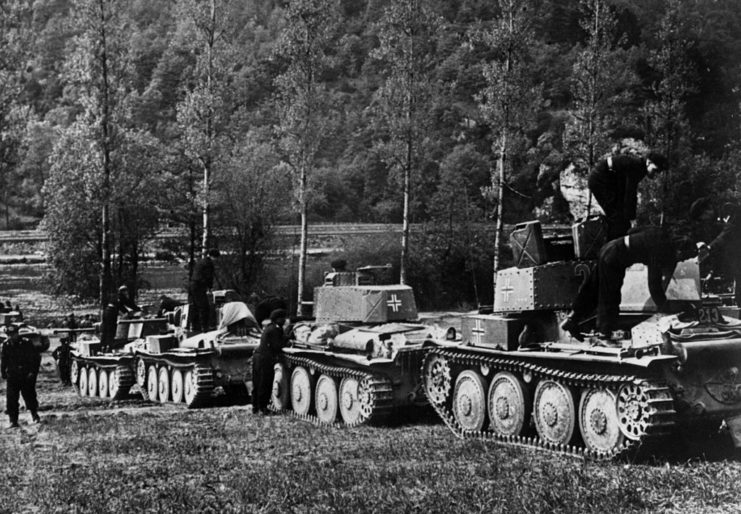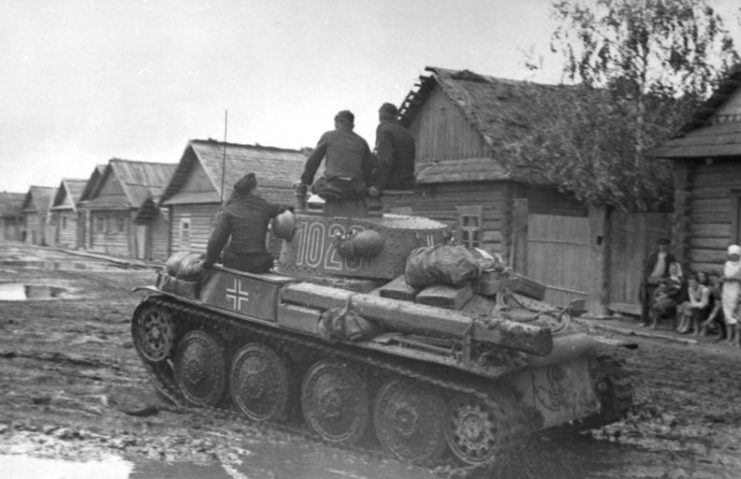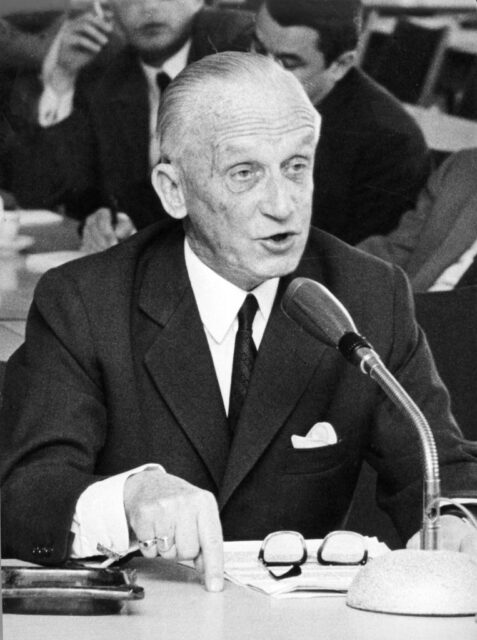The German invasion of France during the middle of 1940 was swift and effective. Within a matter of months, they’d overrun the country’s defenses and were well on their way to conquering other European nations. One of the reasons for their success was the 7th Panzer Division, also known as the “Ghost Division.”
Birth of the 7th Panzer Division

Following the German invasion of Poland, the 2nd Light Division was renamed the 7th Panzer Division. One of the Wehrmacht‘s 10 armored divisions, it consisted of 218 tanks in three battalions, two rifle regiments, an engineer battalion, an antitank battalion and a motorcycle battalion.
In February 1940, Generalmajor Erwin Rommel was named its commander. This was against the opinion of the Chief of Army personnel, who’d recommended he be given command of a mountain division. Rommel had no experience with Germany’s new blitzkrieg operations and had never commanded his own division.
This has led many to speculate that he used his ties to the Führer to obtain the position.
The division was highly regarded in German political circles. The Reichsleiter thought highly of Rommel, and many saw the 7th Panzer Division as part of the country’s propaganda machine. This was due to many of its members holding ties to anti-Semitic organizations.
German invasion of France

The 7th Panzer Division’s first foray into the war would be the invasion of France. Codenamed Fall Gelb, the Germans assembled 135 divisions, including their 10 Panzer units. Erwin Rommel’s served as the center of the XV Panzer Corps, under the command of Generalfeldmarschall Günther von Kluge.
On May 10, 1940, the division crossed the border between Germany and Belgium, with the objective of crossing the Meuse. They experienced little resistance, as the bulk of the Belgian Army was stationed to the north to defend the larger cities.
They met its first major opposition at Chabrehez, but that didn’t stop Rommel’s advance. By the conclusion of the second day, they’d advanced 40 miles, with another 18 covered the next day. Despite the French Army having bolstered its forces, Rommel was able to capture the bridge crossing at the Meuse by the end of May 12, 1940.
While there were some setbacks, including the “Onhaye crisis,” Rommel and the German military continued to see success as they crossed France. A main reason for this was his favoring of night attacks. One example of this was the 7th Panzer Division’s attack on the Maginot Line extension. Rommel breached it by the end of May 16, 1940, destroying the French Ninth Army and its XI and II Corps in the process. It was deemed “the most spectacular German exploit of the day” by author Alistair Horne.
British counterattack

Hoping to stop the German advancement in France, British Prime Minister Winston Churchill charged Major General Giffard le Quesne Martel, commander of the 50th Infantry Division, with launching a counterattack.
Martel planned for two mobile columns to be the main part of his force. It consisted of a tank battalion, infantry from the 151st Brigade, a battery of field artillery, reconnaissance motorcycles and a battery of antitank guns. The French assisted in a limited capacity, offering 60 tanks to join the 58 Matilda Mark I and 16 Mark II tanks the British had enlisted.
The 7th Panzer Division met the British Army’s 6th Motorized Infantry Regiment on May 21, 1940. In Rommel’s opinion, heavy fire was the only option to get them out of the situation. By the end, the division had suffered countless casualties and equipment losses, as had the British.
The attack slowed the division, but it didn’t stop them from traveling north. They continued in the days after, taking siege of Lille and breaching the French line at the Somme.
Praise for the 7th Panzer Division

When the armistice between France and Germany came into effect on June 25, 1940, the 7th Panzer Division was 200 miles from the Spanish frontier. It was put on reserve and sent to the Somme before going to Bordeaux to re-equip for the invasion of Britain. Codenamed Unternehmen Seelöwe, it was eventually called off.
The German campaign in France was deemed “the greatest battle of annihilation of all time” by many. Despite having access to less equipment and military personnel than the French and the Belgians, the Germans had swiftly taken control. The speed at which the 7th Panzer Division was able to achieve success earned them the nickname Gespensterdivision, or “Ghost Division.” Their exploits also delighted Erwin Rommel’s benefactors and assured his advancement within the Wehrmacht.
To help drive home the success, Rommel helped the Reichsleiter produce the propaganda film, Victory in the West. He later published the war diary of the 7th Panzer Division, which was gifted to the Führer by his friend, Rudolf Schmundt.
7th Panzer Division during Operation Barbarossa

In February 1941, the 7th Panzer Division returned to Germany, where General der Panzertruppe Hans von Funck assumed control. Erwin Rommel was promoted to generalleutnant and sent to Libya to command the Afrika Korps during Operation Sonnenblume.
Eventually, the division was stationed near Bonn while preparations were made to invade the Soviet Union. The mission was codenamed Operation Barbarossa. They remained there until June 8, 1941, after which they assembled in east Prussia.
The invasion began on June 22, 1941, and proceeded quickly. Soviet resistance was weaker than expected, allowing the division to cover a lot of land in a small period of time. They were eventually slowed after a series of Soviet-initiated counterattacks, but were able to fend them off after reinforcements from the 20th Panzer Division arrived.
Over the next month, the division joined up with other Panzer divisions. They took control of Soviet towns, as the Red Army was unable to mount a proper linear defense. While there were pockets of resistance, the Germans easily defeated them.
By the middle of July, the 7th Panzer Division was relieved by infantry divisions.
Return to the Eastern Front

After participating in a number of battles against the Soviets, the unit was transferred to France in May 1942. Still under the command of Hans von Funck, they were tasked with coastal protection duties with the 1st Army.
On November 11, 1942, they were sent to the Mediterranean coast, between Perpignan and Narbonne. As the Führer feared a possible continental Allied invasion, preparations were being made to seize the Vichy fleet at Toulon. The mission, which was codenamed Operation Lila, ultimately failed.
Following Operation Lila, the 7th Panzer Division was stationed between Marseille and Avignon, where it remained until January 1943. With conditions deteriorating on the Eastern Front, they were sent back to the Soviet Union, where they fought as members of Army Group Don and participated in the counterattack on Kharkov.
During the summer of 1943, the division fought in the unsuccessful offensive in Kursk, as part of the armored formations of Army Detachment Kempf. They suffered heavy losses. They were subsequently transferred to the XLVIII Panzer Corps, where General der Panzertruppe Hasso von Manteuffel took command.
Two of the last major battles the division fought on the Eastern Front were the Battle of Kiev and the German counterattack at Zhitomir. They also fought in defensive battles during the German retreat through Ukraine.
End of World War II

Throughout 1944 and ’45, the 7th Panzer Division struggled with its lack of strength, as many of its members were new recruits. They experienced issues during defensive battles along the Eastern Front, two of which resulted in them being evacuated by sea. Both instances occurred after the division was transferred to the Baltic States to respond to the Soviet Baltic Offensive.
In September 1944, Germany’s forces fell back during the Battle of Memel, while, in January ’45, they were evacuated from the Hel Peninsula. Both times, they were forced to leave behind heavy equipment.
More from us: Swiss Pikemen: The Most Fearsome Medieval Mercenaries
Want War History Online‘s content sent directly to your inbox? Sign up for our newsletter here!
The end of the 7th Panzer Division came in May 1945. After continuing their defensive fight in northern Germany and Prussia, its surviving members fled into the forest, where they surrendered to the British Army northwest of Berlin.
